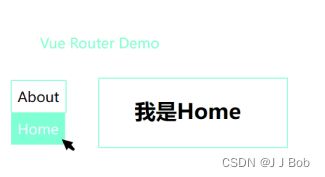Vue笔记(六)vue-router
目录
路由
基本路由
嵌套(多级)路由
路由传参
命名路由
路由的params参数
路由的props配置
编程式路由导航
缓存路由组件
两个新的生命周期钩子
路由守卫
独享守卫(只有前置,后置用全局守卫)
组件内路由守卫
路由器的两种工作模式
vue-router是vue的一个插件库,专门用来实现单页Web应用(single page web application,SPA),SPA整个应用只有一个完整的页面,点击页面中的导航链接不会刷新页面,只会做页面的局部更新,数据需要通过AJAX请求获取。
路由:
一个路由(route)就是一组映射关系(key-value),key为路径,value可能是function或component,多个路由需要路由器(router)管理。
分类:
1.后端路由:value是function,用于处理客户端提交的请求。当服务器收到一个请求时,根据请求路径找到匹配的函数来处理请求,返回响应数据。
2.前端路由:value是component,用于展示页面内容。当浏览器的路径改变时,对应的组件就会显示。
安装与vue2配套的版本:npm i vue-router@3
应用vue-router:Vue.use(VueRouter)
main.js
// 引入Vue
import Vue from 'vue';
// 引入App组件
import App from './App.vue';
// 引入VueRouter
import VueRouter from 'vue-router';
// 引入路由器
import router from './router'
Vue.config.productionTip = false;
// 应用VueRouter
Vue.use(VueRouter);
new Vue({
el:'#app',
// 将App组件放入容器中
render:h=>h(App),
router,
})基本路由:
新建文件:
编写router配置项:index.js
// 此文件专门用于创建整个应用的路由器
// 引入VueRouter
import VueRouter from 'vue-router'
// 引入组件
import About from '../components/About.vue'
import Home from '../components/Home.vue'
// 创建并暴露一个router实例对象
export default new VueRouter({
routes:[
{
path:'/about',
component:About
},
{
path:'/home',
component:Home
}
]
})App.vue
Vue Router Demo
About
Home
路由组件Home.vue
我是Home
路由组件About.vue
我是About
注意:
1.做项目时,一般组件通常放在components文件夹中,路由组件放在与它同级的pages文件夹中。
2.通过切换,被换走的路由组件,默认被销毁,需要时再去挂载。
3.每个组件都有自己的$route属性,里面存储着自己的路由信息。
4.整个应用只有一个router,可以通过组件的$router获取到。
嵌套(多级)路由:
配置路由规则,使用children配置项:
routes:[
{
path:'/about',
component:About
},
{
path:'/home',
component:Home,
children:[
{
// children的path一定不能写成"/children1"(只有根路径前加 "/")
path:'children1',
component:Children1
},
{
path:'children2',
component:Children2
}
]
}
]跳转(要写完整路径):
Children1 路由传参:
传递参数:
Home
Home
Home 接收参数:
$route.query.id
$route.query.title命名路由:
可以简化路由的跳转
给路由命名:
{
path:'/grandpa',
component:Grandpa,
children:[
{
path:'father',
component:Father,
children:[
{
name:'son',
path:'smallest',
component:Son,
}
]
}
]
}简化跳转:
跳转
跳转
跳转 路由的params参数:
配置路由,声明接收params参数:
{
path:'/grandpa',
component:Grandpa,
children:[
{
path:'father',
component:Father,
children:[
{
name:'son',
path:'smallest/:id/:title', //使用占位符声明接收params参数
component:Son,
}
]
}
]
}传递参数:
跳转
跳转 注意:路由携带params参数时,若使用to的对象写法,则不能使用path配置项,必须使用name配置。
接收参数:
$route.params.id
$route.params.title路由的props配置:
让路由组件更方便的收到参数
{
name:'index',
path:'/home/:id',
component:Home,
// 写法一:props值为对象,该对象中所有的key-value的组合最终都会通过props传给Detail组件
props:{a:99}
// 写法二:props为布尔值,布尔值为true,则把路由收到的所有params参数通过props传给Detail组件
props:true
// 写法三:props值为函数,该函数返回的对象中每一组key-value都会通过props传给Detail组件
props(route){
return{
id:route.query.id,
title:route.query.title
}
}
}可以控制路由跳转时操作浏览器历史记录的模式。浏览器的历史记录有两种写入方式:push和replace,push是追加历史记录,replace是替换当前记录(无法回退),路由跳转时默认为push。
开启replace模式:
News
编程式路由导航:
可以不借助
//$router的两个API
this.$router.push({
name:'exam',
params:{
id:xx,
title:xx
}
})
this.$router.replace({
name:'exam',
params:{
id:xx,
title:xx
}
})
this.$router.forward() //前进
this.$router.back() //后退
this.$router.go() //参数为正前进,为负后退缓存路由组件:
让不展示的路由组件保持挂载,不被销毁(include中写组件名)。
两个新的生命周期钩子:
路由组件所独有的两个钩子,用于捕获路由组件的激活状态:
activated路由组件被激活时触发
deactivated路由组件失活时触发
路由守卫:
可以对路由进行权限控制,分为全局守卫、独享守卫、组件内守卫。
全局守卫:
// 全局前置守卫:初始化时执行、每次路由切换前执行
router.beforeEach((to,from,next)=>{
if(to.meta.isAuth){ //判断当前路由是否需要进行权限控制
if(localStorage.getItem('school')==='hzy'){ //权限控制的规则
document.title=to.meta.title||'河中医';
next(); //放行
}else{
alert('无访问权限!');
}
}else{
document.title=to.meta.title ||'河中医';
next()
}
})
// 全局后置守卫:初始化时执行,每次路由切换后执行
router.afterEach((to,from)=>{
if(to.meta.title){
document.title=to.meta.title //修改网页title
}else{
document.title='index'
}
})独享守卫(只有前置,后置用全局守卫):
{
path:'/about',
component:About,
meta:{title:'关于',isAuth:true},
beforeEnter:(to,from,next)=>{
if(to.meta.isAuth){ //判断当前路由是否需要进行权限控制
if(localStorage.getItem('school')==='hzy'){ //权限控制的规则
document.title=to.meta.title||'河中医';
next(); //放行
}else{
alert('无访问权限!');
}
}else{
document.title=to.meta.title ||'河中医';
next()
}
}
}组件内路由守卫:
// 进入守卫,通过路由规则,进入该组件时被调用
beforeRouteEnter (to, from, next) {
// ...
},
// 进入守卫,通过路由规则,离开该组件时被调用
beforeRouteLeave (to, from, next) {
// ...
}路由器的两种工作模式:
对于一个URL来说,“#”及其后面的内容就是hash值,hash值不会包含在HTTP请求中,即hash值不会带给服务器。
hash模式:
1.地址中永远带着“#”。
2.若以后将地址通过第三方手机APP分享,若APP校验合格,则地址会被标记为不合法。
3.兼容性较好。
history模式:
1.地址干净美观。
2.兼容性略差。
3.应用部署上线时需要其它部门人员支持,解决刷新页面服务端404的问题。
(视频:B站尚硅谷)


